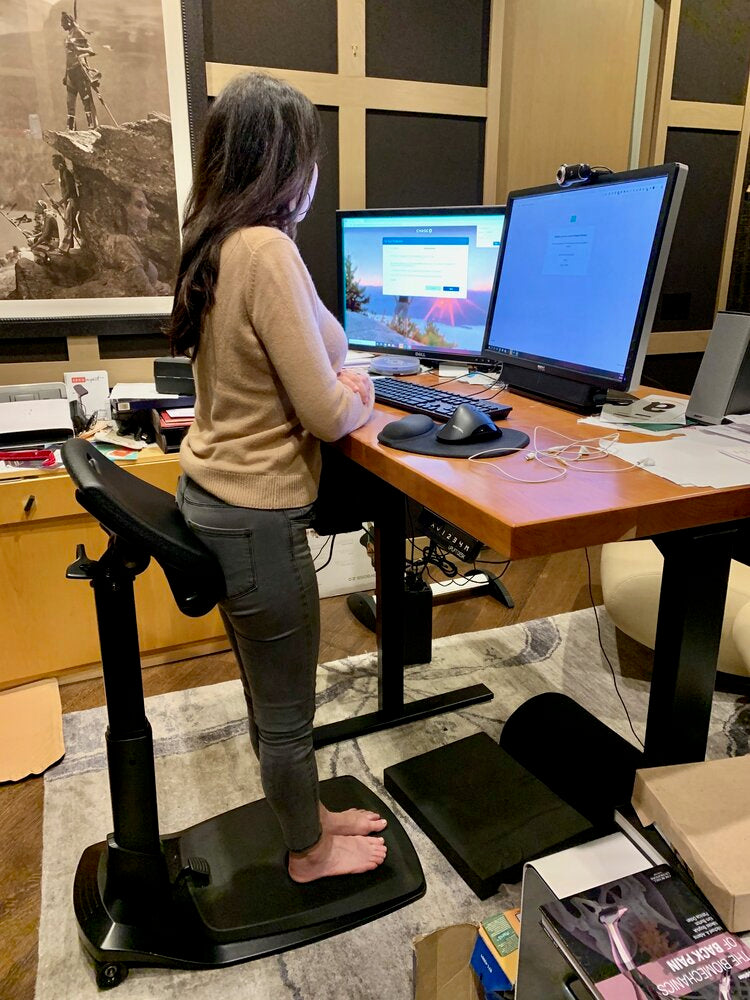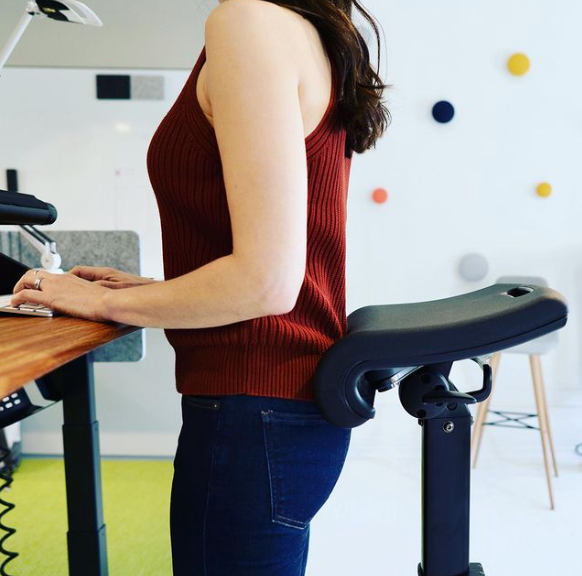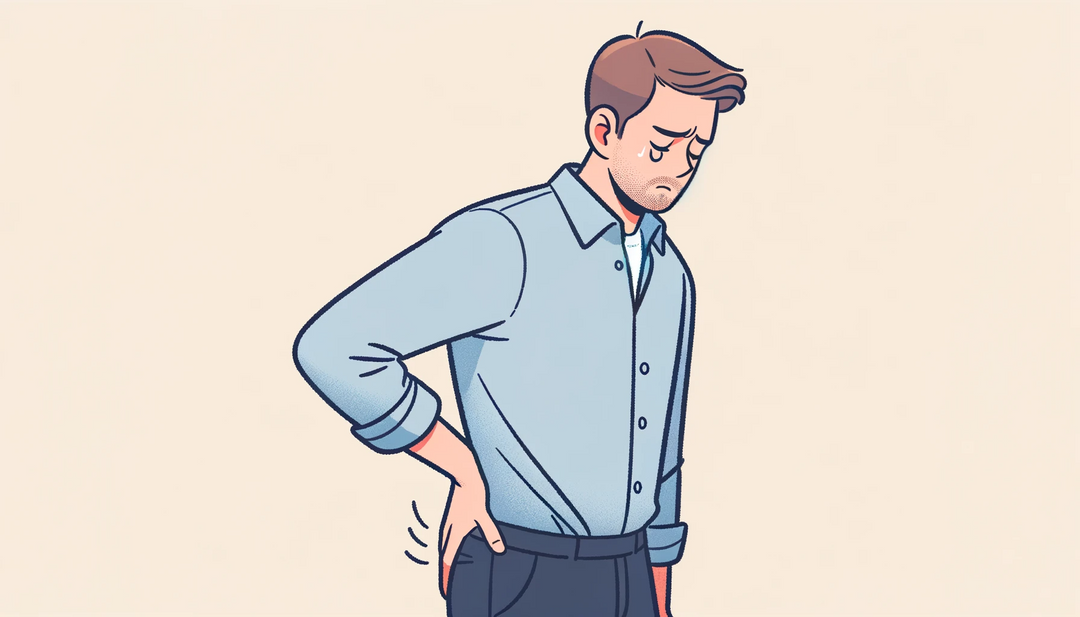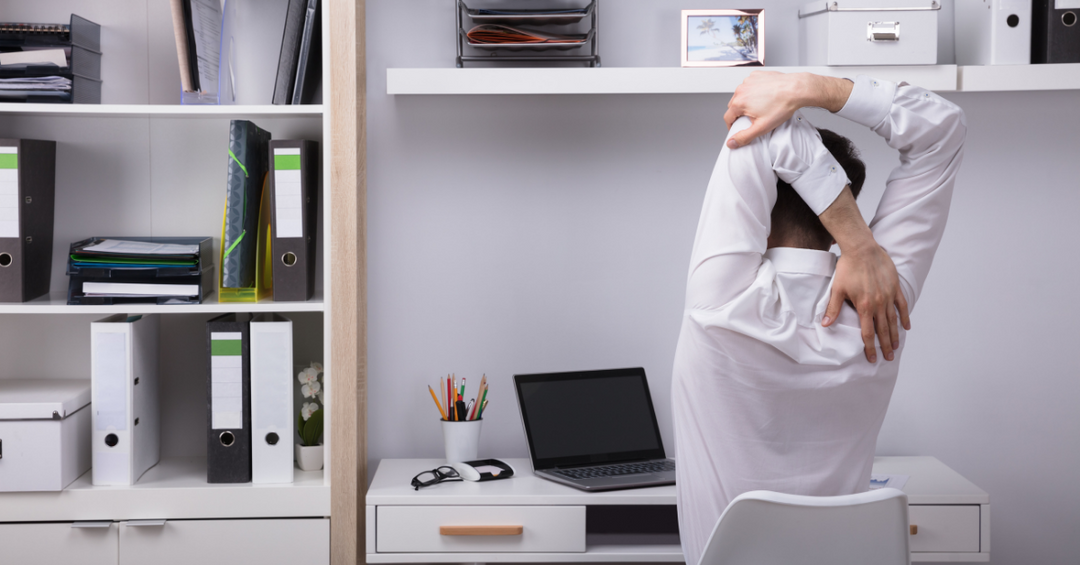4 work from home tips to maintain health, focus, and work-life balance

So most of us are working from home. Some of us for the first time. The truth is, even work-from-home pros struggle to maintain the basics: health, focus, and work-life balance. Regardless of which group you fall into, these 4 tips will set you up for success.
Tip #1: Optimize the ergonomics of your home office setup
Tip #2: Exercise and stretch regularly
Tip #3: Take scheduled micro-breaks and set a definitive sign-off time
Tip #4: Use music and ambient sound to help you focus
Tip #1: Optimize the ergonomics of your home office setup
Do you struggle with low back pain? Neck or eye strain? Poor posture? All of these can be addressed by ergonomic solutions like standing desks, footrests, and laptop risers.
With no colleagues, you have a unique opportunity to test out tweaks to your setup without feeling awkward or distracting anyone. Why not spend some of the time you used to spend commuting, on improving your setup? An investment in your workspace is an investment in your health and well-being. And, perhaps most importantly, your setup plays a vital role in protecting your focus. Especially at home, where you may share your space with other family members.
The basics, good home office ergonomics in 3 steps…
Step 1: Elevate your screen and connect an external mouse and keyboard
Start by elevating your laptop, so the screen is at eye-level. You can use cookbooks, wood, or whatever solid ‘building blocks’ you have lying around the house. Once elevated, slide your laptop forward or backward, so the screen is about an arm’s length from your eyes. Then connect an external mouse and keyboard. You want to be able to comfortably view your screen AND comfortably type or mouse at the same time.
Without a doubt, you will dig the change. These adjustments will encourage better posture. And elevating your screen has a beautiful way of making your setup feel more ‘legit.’ More permanent and versatile solutions to consider would be a laptop riser or stand, or a monitor mount or arm.
If your eyes often feel tired, strained, or dry at the end of the day, consider blue light filtering glasses. Or consider changing the display settings on your computer monitor to a warmer tone. It can also be beneficial to look off into the distance regularly — a phone reminder can help you remember to do this.

Step 2: Seriously consider investing in a sit-stand desk and standing desk chair — the dynamic duo
We advise you to choose a sit-stand height-adjustable desk rather than a fixed height standing desk. A sit-stand height-adjustable desk will allow you to switch easily between sitting and standing throughout the day.
Our second piece of advice is to pair your standing desk with a standing desk chair. Whether your desk is fixed height or height-adjustable, a standing desk chair completes your standing desk setup. It adjusts to support your body in a variety of working postures, ranging from sit to stand. If one of your goals is to sit less and move more, a standing desk chair makes it easier to reach your goal.
→ Unfamiliar with standing desk chairs? Our blog post What IS a Standing Desk Chair? was written for you.
Benefits of a standing desk chair
-
Provides ‘standing support’ to the glutes and lumbar region, making the transition from sitting to standing easier and more comfortable
-
Allows optimum distribution of your weight through your core and legs by providing fine-grain adjustment of seat pitch and chair height
-
Supports a ‘perching’ posture — a posture proven to reduce low back pain
-
Puts the spine and pelvis in neutral position
-
Adjusts effortlessly and dynamically to support multiple comfortable positions — this allows you to remain active throughout the workday
And our advice on standing desk chairs? Hone in on highly adjustable ones like our LeanRite™ Elite. Both the stem height and seat pan of the LeanRite™ adjust — you can set the stem at any height in its range, and the seat pan at 3 different angles. As you move stem height and seat pan, trying out different positions, you’ll discover something unique and brilliant: precise control over the distribution of your body’s weight through your core and legs. This control allows you to achieve the postures most comfortable for you. We’re all built differently, so a highly adjustable chair that moves dynamically helps you find your most comfortable postures. A bonus — our LeanRite™ Elite comes with an integrated anti-fatigue mat that provides extra cushion and support for your feet and legs.
→ Confused about conflicting headlines and advice regarding the standing desk? Here’s a worthwhile read for you: Are standing desks ergonomic?. Spoiler alert: The answer is YES. But only if paired with an anti-fatigue mat, a raised footrest, and a standing desk chair.

Step 3: Complete your setup with an ergonomic footrest
A footrest elevates your feet to a comfortable position and allows you to move and stretch your legs throughout the day, keeping them in motion. When working standing up, it allows you to elevate one foot at a time, the same way you would at a bar counter. The subtle variety in posture keeps your body active and engaged. Our blog post The Ergonomic Footrest: an Essential Accessory to Any Desk — Sitting, Standing, or Height-adjustable offers the complete lowdown. A footrest makes your standing desk setup complete.
If you want to ‘try before you buy,’ experiment with a milk crate, barstool, or seat cushion.
Tip #2: Exercise and stretch regularly
“The bottom line is that by staying active, moving, and connected, you gain the reward of having energy all day, sleeping well at night, and feeling healthy, happy, and fulfilled. Just remember — your body is designed to move”-Dr. Joan Vernikos
Although the gym may be closed, YouTube is stocked with millions of guided workouts — full-body pilates sessions, HIIT workouts, Vinyasa flow yoga classes, you name it. And hundreds of expert instructors are streaming free workouts every day, as their act of charity. With more control over your schedule, you can try working out at different times — first thing in the morning, at the ‘2 in the afternoon slump,’ or at 7 every evening. Experiment to find the workout time that gives you your best, sustaining energy.

→ Speaking of physical activity, check out our blog post What NASA Scientist Joan Vernikos Teaches Us About Standing Desks. Dr. Vernikos simplifies the grim science about how a sedentary lifestyle degrades our health. She clarifies the role a standing desk plays in turning the ship around.
Tip #3: Take scheduled micro-breaks and set a definitive sign-off time
These two tips are big for work-life balance.
Working from home gives you the freedom to schedule your day based on your natural energy level. Take a micro-break every 30-minutes or so. The line between ‘work’ and ‘life’ can get blurry when you don’t go into the office. So work intentionally, taking micro-breaks throughout the day.
We recommend that you take two kinds of micro-breaks: breaks for your mind and breaks for your body. These can sometimes be one in the same. Mental breaks help you forget about work (and stress) for 10-15 minutes. A mental break can be a coffee, a snack, or a small chore — whichever activity is easiest for you to fully immerse in. And breaks for your body like walks, stretches, and yoga sequences are movement-based ‘resets’ that stretch out the lower back and hamstrings, or wherever you have tension and tightness. Pro tip here: take a walk outside every day. You won’t regret it.
→ If you are stumped about the cause/cure of your low back pain, see our blog: A Perching Posture Proven to Be Ideal for Lower Back Pain. Recent science shows a perching posture puts the spine in neutral position, reducing low back pain. What is perching, exactly? A semi-standing posture, with the knees slightly bent and pelvis tilted forward — one of multiple postures our LeanRite™ Elite supports.
To further establish that line between ‘work’ and ‘life,’ set a defined sign-off time and sign off, every day, at that time. If you struggle to unplug, try out rituals like listing the day’s achievements or writing tomorrow’s to-do list, or packing up all of your tech as if you’re leaving the office. Again, whatever works for you. Here’s a creative idea: self-massage. Just 15 minutes of massage can relieve anxiety and stress, boost your immune system, allow deeper breathing, and improve your posture. A 15-minute massage might be just the thing to help you shift into a lower gear at the end of your workday.
Tip #4: Use music and ambient sound to help you focus
With no coworkers, you can be the conductor of the noise around you. Why not take full advantage of the opportunity to discover and perfect your ambiance? Different types and volumes of music and sound will cater to different types of tasks. Here are some science-based pointers to get you started…
If you need a low-key soundtrack to mask distracting noise around you, turn to nature sounds
Research from Rensselaer Polytechnic Institute finds tuning into “natural sounds” can enhance cognitive function, optimize concentration, and improve your mood. Note: pick soundtracks that showcase flowing water and soft rain instead of more jarring nature noises like birds and cracking thunder.
To improve your mood and boost your productivity, queue your favorite songs
Teresa Lesiuk with the University of Windsor finds listening to music of your choice improves your overall mood and productivity level. If you need to kick your workday into a higher gear, try queueing your favorite songs.
If you get carried away by complex musical structures, stream simpler music
Research out of Fu Jen Catholic University in Taiwan finds listening to music you strongly like or dislike reduces your ability to concentrate. Better results come from listening to music you feel neutrally about.
If you’re a “wordie” and the lyrics distract you, listen to instrumental music
According to research from the Finnish Institute of Occupational Health and University of Turku, intelligible speech (in music), reduces your cognitive functioning. If this finding resonates for you, try binaural focus beats, classical music, or a video game soundtrack.
If you typically find flow at a coffee shop, create your own “coffee shop” ambiance
Turn on the TV at a low volume, stream white noise through your headphones, crack the window to let in the sound of birds chirping, or press play on one of YouTube’s many ‘ambient music’ playlists.
Experiment with volume levels
Researchers from the Universities of Illinois, British Columbia, and Virginia found that a moderate (~70 dB, medium volume) level of noise increases creativity. Why? Increasing processing difficulty induces a higher construal level and promotes abstract processing. A higher noise level (~ 85 dB), on the other hand, reduces the extent of information processing and thus impairs creativity, and is better suited for repetitive tasks. So experiment with different volume levels as you work, depending on the task at hand.
→ Distracted by back pain? Our blog Does Sitting Cause Back Pain? Ask the TED Talk doctor! illustrates how sitting can lead to muscle imbalances, unhealthy movement patterns, and back pain. The 3 bonafide hacks for rebuilding healthy movement patterns are strengthening your core, moving more, and moving mindfully. Staying active is crucial for mobility and functional movement.







Leave a comment